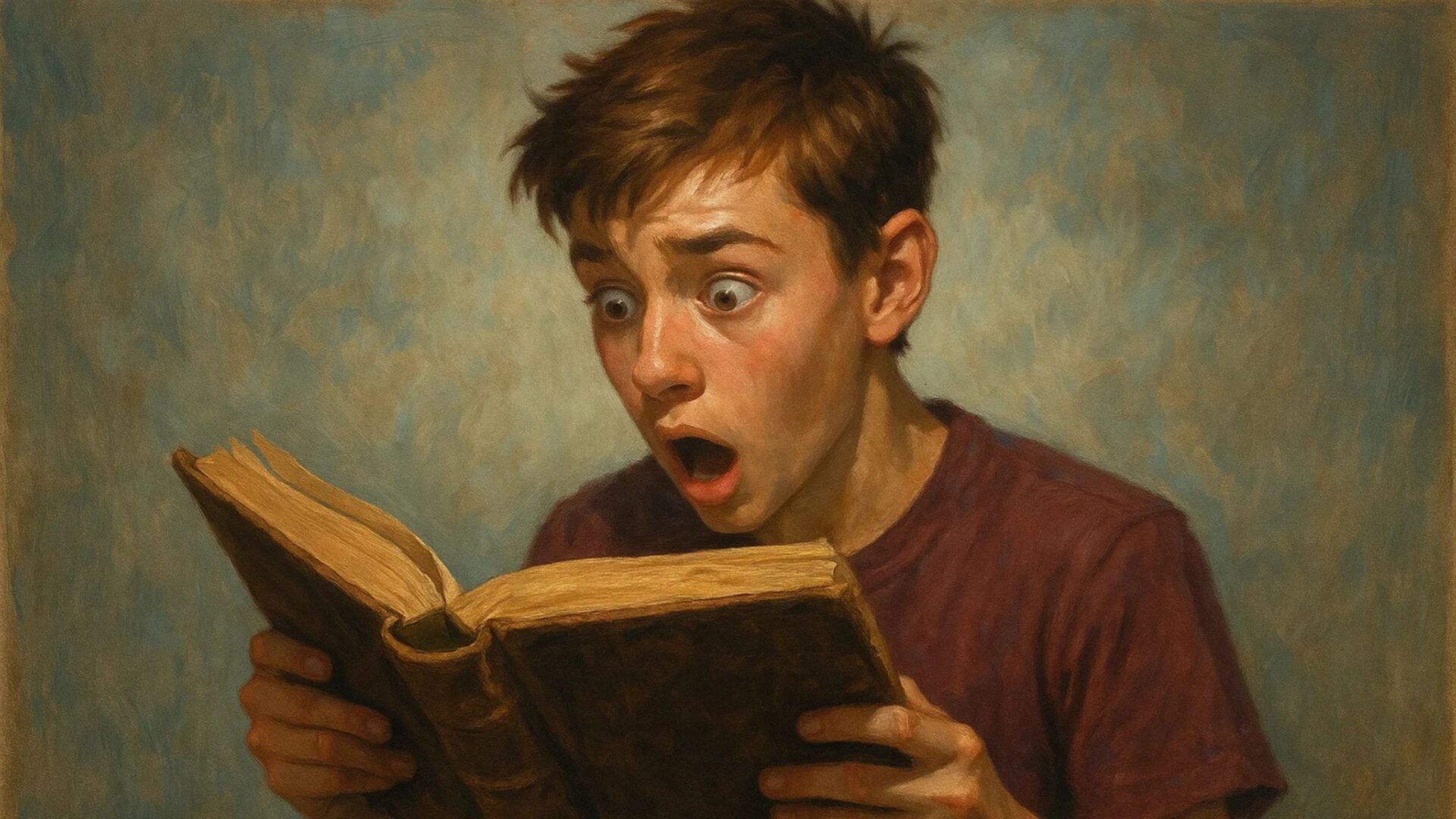Books and Identity: When the Page Becomes the Path
In the sterile logic of psychological theory, identity formation in adolescence is understood through models like Erik Erikson’s stages of psychosocial development. During this period—between ages 12 to 18—individuals are navigating the crucial crisis of identity vs. role confusion (Erikson, 1968). They are not just asking “Who am I?” but also “Who am I not?”
But textbooks don’t tell you what happens when a teenage boy picks up The Doors of Perception on a rainy Tuesday in a public library and starts wondering if the universe is made of acid and breathing walls. No, Erikson didn’t drop mescaline in the desert. But that boy did. And the world changed.
“I saw God. Or maybe it was the wallpaper bleeding light. Either way, I didn’t care about algebra after that.”
He started microdosing psilocybin on Wednesdays, talking about Aldous Huxley like he was some shaman, while his grades slipped into oblivion. What started as curiosity—the kind encouraged by every self-help parenting book—morphed into a daily dive into the psychedelic unknown. And that’s the thing: books don’t end on the last page. They echo.
Another teenager reads Modern Warfare Magazine. Camouflage spreads, gun reviews, high-res pictures of American soldiers standing like metal gods in desert heat. The message is clear: there is glory in firepower. So he signs up for a shooting range class. AR-15, Glock 19, the whole catalog. He learns to shoot between heartbeats. He calls it discipline. His mother calls it “just a phase.” His father calls it “finally something useful.”
“I don’t know if I want to kill anybody. I just want to know I could.”
He hasn’t enlisted yet, but the smell of gun oil makes him feel whole. As if all the fragmented parts of his teenage rage and impotence now have an outlet, a focus. The book, the magazine—whatever you call it—gave him a weapon before he ever touched one.
And then there’s the girl. Quiet, soft-eyed, raised on history books and biographies of artists who died broke and famous. She read about Goya’s madness and Van Gogh’s severed ear. She read until she could see brushstrokes in her sleep. By seventeen, she was painting war scenes and naked bodies in her garage. By nineteen, she was living in a crumbling loft in SoHo, with three roommates, two cats, and one dream.
“My parents wanted a dentist. I gave them blood-red acrylic on canvas.”
She believed in beauty the way addicts believe in heroin: absolutely. Books lit the fire, art made it burn.
And somewhere else—maybe in a Catholic school, maybe in a public library—another girl reads Sappho. She’s seventeen and unsure. Her body knows before her brain does. Sappho’s verses aren’t graphic, but they’re devastating. Words like velvet hammers:
“I don’t know what to do, two states of mind in me.”
She rereads it. And something ancient clicks inside her ribcage. This isn’t just a poem. It’s permission. It’s someone who lived and loved and named it. A century before TikTok labels, before safe spaces—just a poem on a page.
And now she’s writing her own.
The Psychology Behind the Page
In psychology, this is called narrative identity—the internalized story one constructs about oneself (McAdams, 2001). Books serve as scripts, possibilities, provocations. They do not simply inform; they transform. According to social learning theory (Bandura, 1977), behavior is learned by observing models. But who says models have to be people? Sometimes, they’re printed in serif font and shelved under “Philosophy” or “Military Studies.”
Books are maps, but they don’t come with compasses. One teen may find enlightenment. Another may find a bullet. Both began with a story.
The Silent Words
Books have always been quiet revolutionaries—pages that tilt empires and rewire minds. Take Malcolm X, who found himself in a prison cell with nothing but time and a dictionary. He copied it word for word, page by page, until language became his weapon. “Books opened up a whole new world to me,” he said, and that world turned him from hustler to prophet. Or Adolf Hitler, who devoured nationalist literature and obscure racial theories—his obsession with Mein Kampf, first as a thought and later as a publication, would go on to stain the 20th century in blood. Contrast that with Frederick Douglass, who stole literacy under threat of death. When he read The Columbian Orator, it cracked open his understanding of human rights and rhetoric. Books gave him not just ideas, but power. Go further back, and there’s Marcus Aurelius, the Roman emperor scribbling Stoic philosophy in Meditations, never knowing his private reflections would shape the ethics of millions long after Rome turned to dust. Or Joan of Arc, who heard voices, yes—but was also moved by religious texts that convinced her of divine purpose. Che Guevara read Marx and was never the same. Gandhi read Tolstoy and dropped his lawyer’s wig for a loincloth and revolution. Books don’t just sit on shelves; they sit behind every turning point in history, whispering directions into the ears of those mad—or brave—enough to listen.
A Pen, Sharper Then Two Edged Sword
They say the sword conquers bodies, but the pen conquers minds—and minds last longer than empires.
A sword can take a life; a pen can shape millions. Revolutions don’t begin on battlefields—they begin in ideas, in books, in quiet corners where someone dares to write the truth. Common Sense by Thomas Paine sparked the American Revolution more than any musket. Uncle Tom’s Cabin stirred the conscience of a divided nation. The Communist Manifesto birthed movements across continents. Even tyrants feared the written word—Hitler burned books because he knew they could outlive him.
You can silence a man with a sword, but with a pen, you make him immortal.
They say you can win more wars with a pen than with a sword. And it’s true—history proves it every damn time. The sword bleeds you out on the ground, but the pen? The pen bleeds into generations. A sword conquers the body, the pen conquers the soul. The sword needs a battlefield. The pen only needs a page.
Thomas Paine’s Common Sense fired more shots than any colonial rifle. Karl Marx never picked up a rifle, yet his Manifesto lit fires from Moscow to Havana. Harriet Beecher Stowe wrote Uncle Tom’s Cabin, and Lincoln—half-joking, half in awe—called her the little lady who started the big war. Hell, even Mein Kampf was a manifesto in ink before it was a movement in iron and blood. It’s not always pretty. The pen builds and destroys. It’s a loaded weapon with no safety.
Bukowski once said, “The problem with the world is that the intelligent people are full of doubts, while the stupid ones are full of confidence.” But give that doubtful mind a pen, and it becomes dangerous—because the best words come from pain, confusion, and a desire to rip through the bullshit.
The pen doesn’t rush in—it festers. It lingers. It changes hearts in silence. The sword screams and dies. The pen whispers and survives. Books are the long con of revolution. Tyrants burn them because they know their real power. “Writing,” Bukowski growled, “doesn’t rescue you,”—but it might rescue someone else. It might make one kid in one town question the whole machine. That’s enough. That’s war.
You want to change the world? Forget the blade. Sharpen the pen. And bleed your truth into the bastards.
And Then There’s the Bible
And then there’s the Bible—the most dangerous, beloved, banned, misused, and life-giving book the world has ever known. Not just scripture, but a mirror that turned shepherds into kings and murderers into saints. It reshaped identities at the deepest level—turned fishermen into apostles, tax collectors into martyrs, slaves into free men, and cowards into lion-hearted prophets. The Bible didn’t just whisper into history—it roared. Empires rose and fell by its verses. The Reformation shattered the grip of the Catholic Church not with violence, but with a German monk nailing scripture to a door. Sola scriptura—only the Word—was the sword that split the West. It inspired revolutions, comforted the dying, justified wars, and ended them too. It crossed oceans, rode in saddlebags, hid in coat pockets, and echoed in slave fields. “The truth shall make you free” wasn’t just theology—it was identity, rebellion, hope. And like Bukowski said about great writing: “It bursts in on you with a burning roar.” That’s what the Bible did. It wasn’t always gentle. But it changed men more than laws ever could. It didn’t just point to heaven—it tore up the earth.
Take Martin Luther, a guilt-ridden monk pacing the cold stone halls of a German monastery, wracked with fear of damnation, confessing so often his priest begged him to stop. Then one day, he actually read the Bible—not just memorized it, not just chanted it in Latin—but read it, devoured it, bled with it. And it hit him like a fist to the gut: salvation was by grace, not by buying indulgences or crawling on your knees through Vatican dust. So he grabbed a hammer and nailed 95 furious theses to a church door in Wittenberg like a man possessed. They thought it was an academic debate. Instead, it lit Europe on fire. He went from quiet monk to spiritual outlaw. He translated the Holy Scriptures into German so every farmer, blacksmith, and brewer could read the words of God for themselves, without the Pope’s golden filter. And as if that wasn’t scandal enough, he smuggled a dozen nuns out of a convent hidden in fish barrels, and married one—Katharina von Bora, a woman as fierce and stubborn as he was. Together they raised six children, brewed their own beer, and built a home that became a hub of Reformation thought. Luther didn’t just challenge Rome—he ripped the mask off religion, exposed the machinery, and gave the people back their voice. Like Bukowski wrote, “There’s a light somewhere. It may not be much light but it beats the darkness.” That’s what Luther did. He struck a match in the dark and handed it to the people.
References
-
Bandura, A. (1977). Social Learning Theory. Prentice-Hall.
-
Erikson, E. H. (1968). Identity: Youth and Crisis. W. W. Norton & Company.
-
McAdams, D. P. (2001). The psychology of life stories. Review of General Psychology, 5(2), 100–122.




